The Colmenera Farm’s Ecobiopsychosocial Capital: A Bioregional Approach
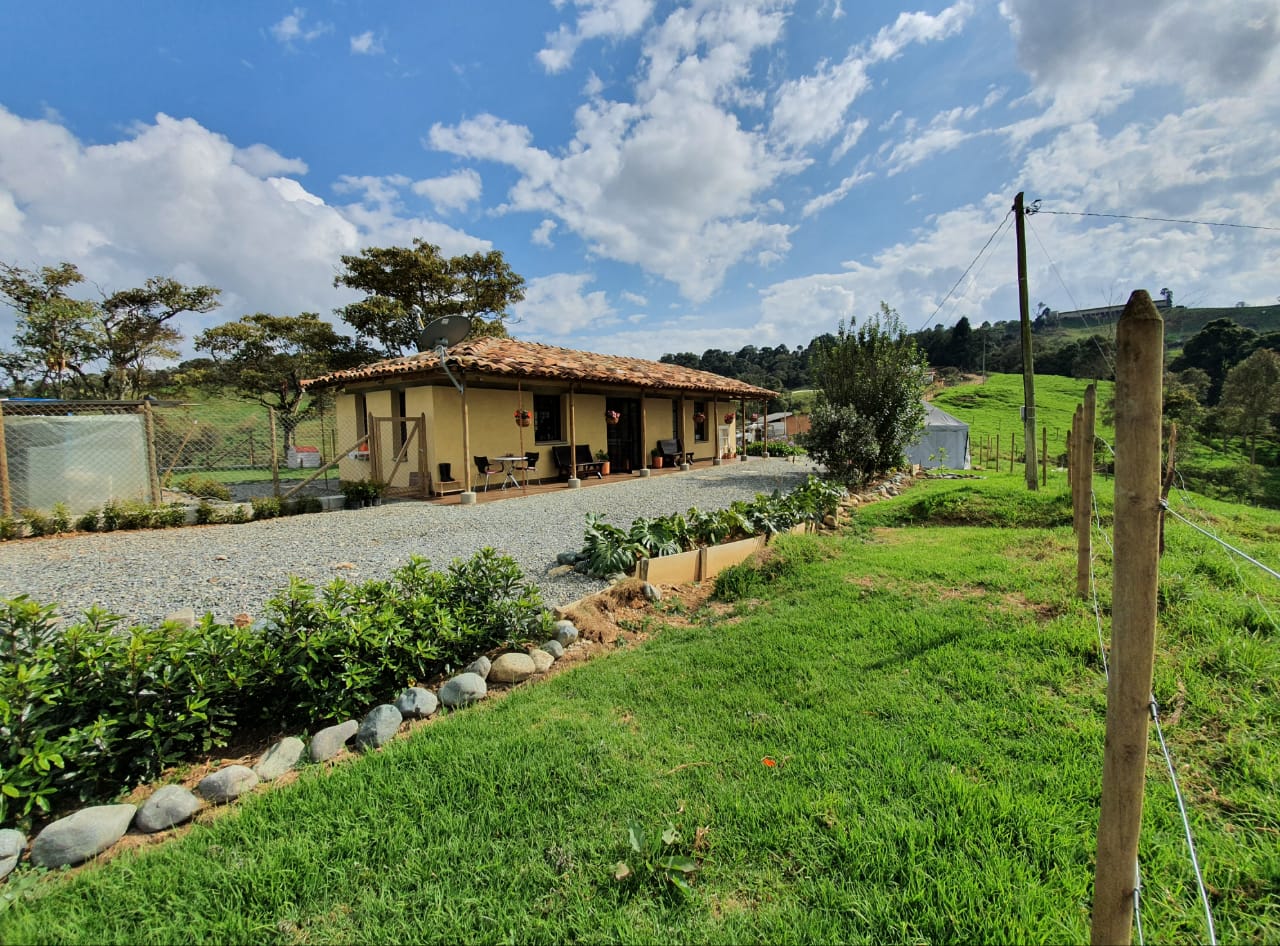
Times of crisis compel to leave comfort zones and therefore they become both in opportunities of learning and social change. COVID-19, the pandemic that humankind [1*] faces today reminds us we are not at the top, split from the web of life; that we hinge on Mother Nature’s choices further than ours. Likewise, such contagious micro-organic system has also spread critical thinking on our prevalent socio-economic model, on our lives as usual. And since every cloud has a silver lining, the bout of coronavirus has not only transmitted disease but it seems to relieve our solidarity [2*] by means of systems thinking and action [3*].
 Homo Sapiens Reciprocans: An Ecobiopsychosocial Conception of Humankind
Homo Sapiens Reciprocans: An Ecobiopsychosocial Conception of Humankind
Juan Sebastián Cárdenas Salas (2017)
Because of Gaia Education Design for Sustainability (GEDS) program, it is possible to address paths to collectively work for planetary health. That is, to foster in a systemic / mutual form a necessary shift that harmonizes our ‘interbeing’ with the whole community of life. Thus, the idea of developing what I have dubbed The Ecobiopsychosocial Capital as holistic approach precisely arises throughout the GEDS’ four inspiring dimensions [4*]. Although this idea came up on ‘me’, by no means I regard it ‘mine’ [5*]. The Design Studio exercise in turning theory into practice has been a wonderful chance of teaming up with fellows who also wish to reach out a regenerative human presence all over the Oikos: the Household.
The Ecobiopsychosocial Capital as New Mindset for Planetary Health
¿What is the Ecobiopsychosocial Capital?
I want to roughly explain to the reader what from my point of view the Ecobiopsychosocial Capital (henceforth the EBPS Capital) is, and why it is the main thrust of the regenerative design process I’m describing herein. The EBPS Capital essentially is an emerging cultural model in evolution that seeks to inclusively contribute to planetary health. As Wahl (2016) [6*] infers, a regenerative human culture is one that “cares for the planet and life” by rising the adaptability, resilience and healthy growth of the complex “eco-psycho-social systems” whereby we participate. It recognizes design for sustainability as an effective option to “create a thriving future for all of humanity.”
In this manner, the EBPS Capital aims to amend the notions of ‘wealth’,‘ prosperity’, ‘success’, among others we have absorbed through traditional anthropocentric education sponsored by the Capitalistic selfish model. A mindset which has undoubtedly shaped most of human organizations (especially business as usual). Those ‘revaluations’ then pursue not only benefits for humans but the sake for the entire web of life. Furthermore, it’s an approach to grasping the four capitals conveyed by ecological economics as a whole: Environmental Capital, Human Capital, Social Capital and Economic Capital.
From EGO to ECO Mindset
The scheme (see graphic) on the switch from the governing model in which we are stuck on towards a mutual ‘ECO paradigm’ –a matter of the utmost importance to find a vaccine against our cartesian view of life– accurately expresses the prime intention of the EBPS Capital: situating ecology as the crux of human priorities.
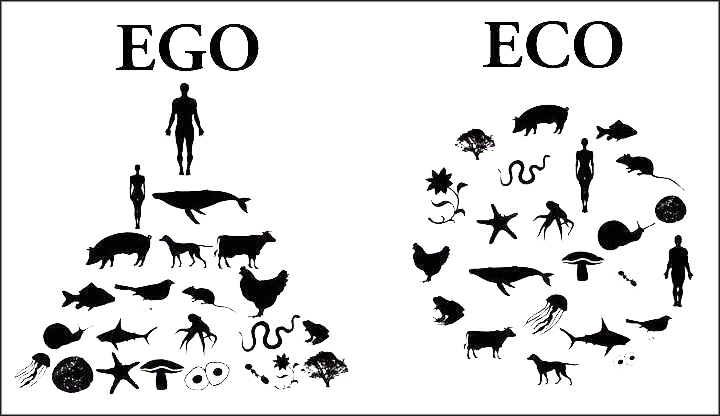
From EGO to ECO Paradigm (thenatureofbusiness.org)
Connecting The Dots: The EBPS Capital Basis
There are several facts that have led me to think of the EBPS Capital. Nonetheless, I will briefly describe those I consider the foremost to reach my actual state as systems thinker, ecosocial practitioner and now as a regenerative designer for planetary health.
Approaching holistic science
More than 16 years ago in my career in the fields of marketing and communications I started coming to grips with some of the usual disconnects that corporations face between their Being, Doing and Saying[7*]. Realization that brought me closer to think human organizations differently. So that, roughly over the last eight years, I started thinking of organizations as “beings” rather than “brands”, and consequently, I have been diving into a science of the whole better known as The Systems View of Life as an accomplishment to understand organizations as living, conversational, reflexive, and interdependent entities, i.e., as ‘organisms’ that alike other beings of Earth are frequently grappling with ecobiopsychosocial conditions.
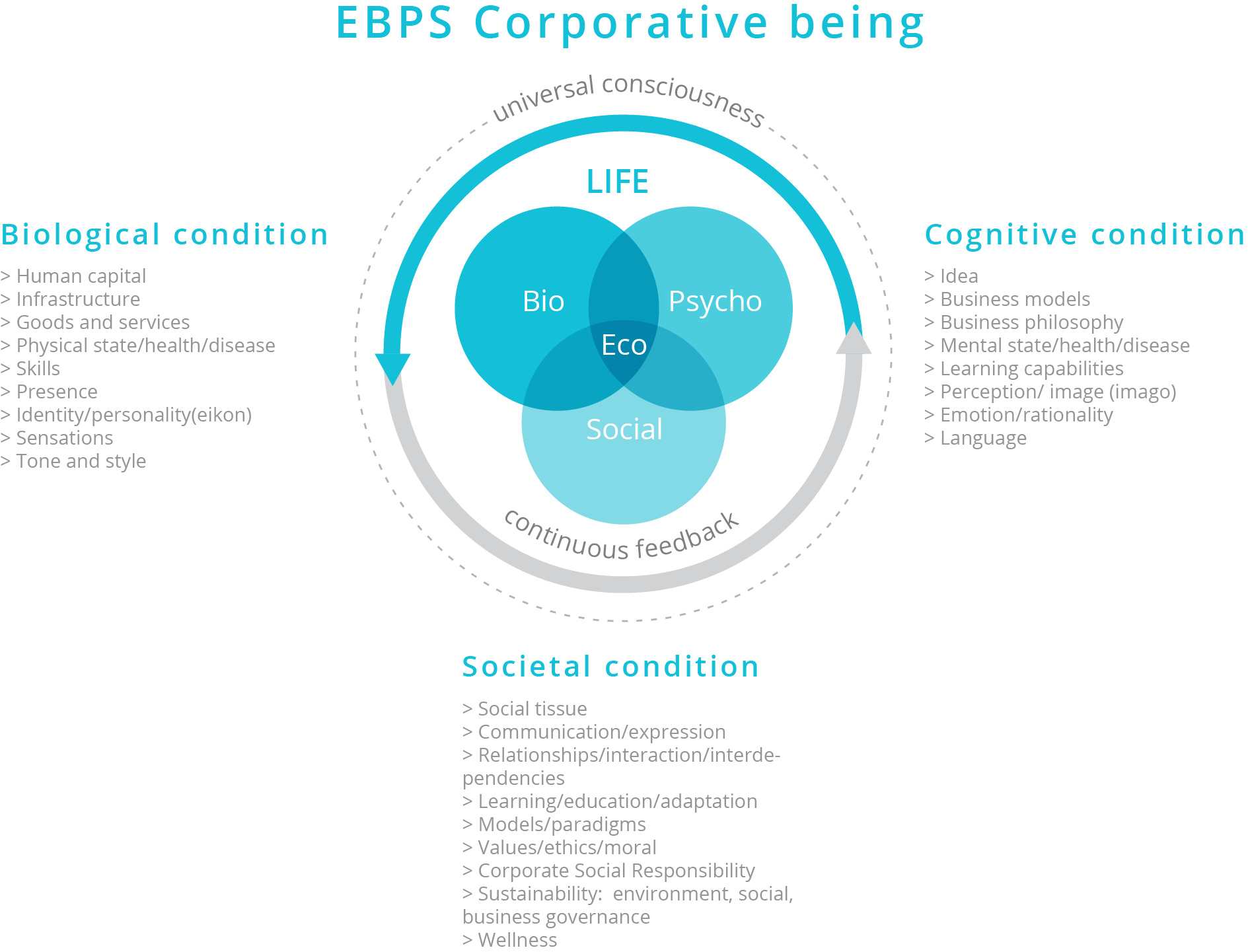
Ecobiopsychosocial Corporative Being – Jscinteractivo©
The Biopsychosocial Model
The systemic Biopsychosocial Model devised by the psychiatrist George L. Engel by the end of 70’s was one of the most relevant key points I connected to The EBPS Capital as Salutogenic approach. Moved by The General Systems Theory of Ludwig von Bertalanffy, Dr. Engel asserted how the ‘stodgy’ Biomedical model clearly excludes –and still ongoing– the social, psychological, and behavioral dimensions of illness from its framework (Engel, 1977) [8*]. In opposition to such reductionist notion of human disease, He foresaw an urgent need of evolving the work of physicians by dint of a new medical holistic approach:
We are now faced with the necessity and challenge to broaden the approach to disease to include the psychosocial without sacrificing the enormous advantages of the biomedical approach. On the importance of the latter all agree, the reductionist, the exclusionist, and the heretic. (Engel, 1977)
Now, more than forty years after Engel’s realization, I’m intended to foster a new advance in the realms of organizational behavior, development and health within the EBPS Capital as a Salutogenic source. A model for healing, as I said before, the relation of human organizations with the web of life. Or in other words, with Ecology.
Developing Living Organizations
Such realization pushed me to recently give form to a consultancy approach in the realm of Organizational Development (OD) I dubbed Jscinteractivo. Ecosocial enterprise derived from holistic science [9*] which, inter alia, aims to adapt learning capacities, health and organizational resilience in companies. For instance, through recognizing the coherence between their Being, Doing, and Saying (or Trilogy of Integrity), fostering adaptive leadership in coping with new realities, widely adapting the Sustainable Development Goals (SDGs) in business organizational issues, as well as addressing organizational identity and communication via the Trilogy of Integrity. Due to both the GEDS program’s four dimensions and the Design Studio I also keep going into an ecology of mind to keep incorporating changes in business as usual.
The Colmenera Farm’s Ecobiopsychosocial Capital: Case Study, Design Studio’s Goal and Project’s Outlook
While ago, a beautiful Spanish word said by a permaculturist farmer inspired me: ‘Lecturaleza’ (reading Nature). Term that keenly express the life decision Claudia (my partner) and I made in order to start working on an idea committed to honoring Nature as Mother and Teacher. The intent to delve into it was indeed the key for my enrollment in the GEDS program and what encouraged me to be proponent for the Design Studio exercise.
We began this permacultural endeavor almost a year ago in a rural zone of the Antioquia’s (Colombia) Northern municipality called San Pedro de los Milagros, where The Colmenera’s Farm is located. There we inhabit 1.62 hectares at a height of 2,485 meters above the sea level. Firstly, we restored/built a rammed earth house with more than 100 years based on bioarchitecture/bioconstruction guidelines as the permaculture’s core zone. It was the household of my partner’s grandparents (traditional farmers) more than 70 years ago. Today La Colmenera is our home and the heart of a project where we are cultivating the EBPS Capital.
By the time I presented the Colmenera’s case study proposal to the GEDS’s facilitators, I had the honor of being proponent and also the chance of leading, linking and flying together with a group of four fellow regenerative designers around the world towards conceiving our purpose.
In short, my main concern for the Design Studio was to address an extending method that would enable us to firstly demonstrate the Colmenera’s EBPS Capital. Moreover, that such bioregional model could be later entailed as an asset by the San Pedro’s local administration, as well as a route of regenerative design at other ‘glocal’ initiatives in order to additionally achieve the UN Sustainable Development Goals (SDGs) expected for 2030.
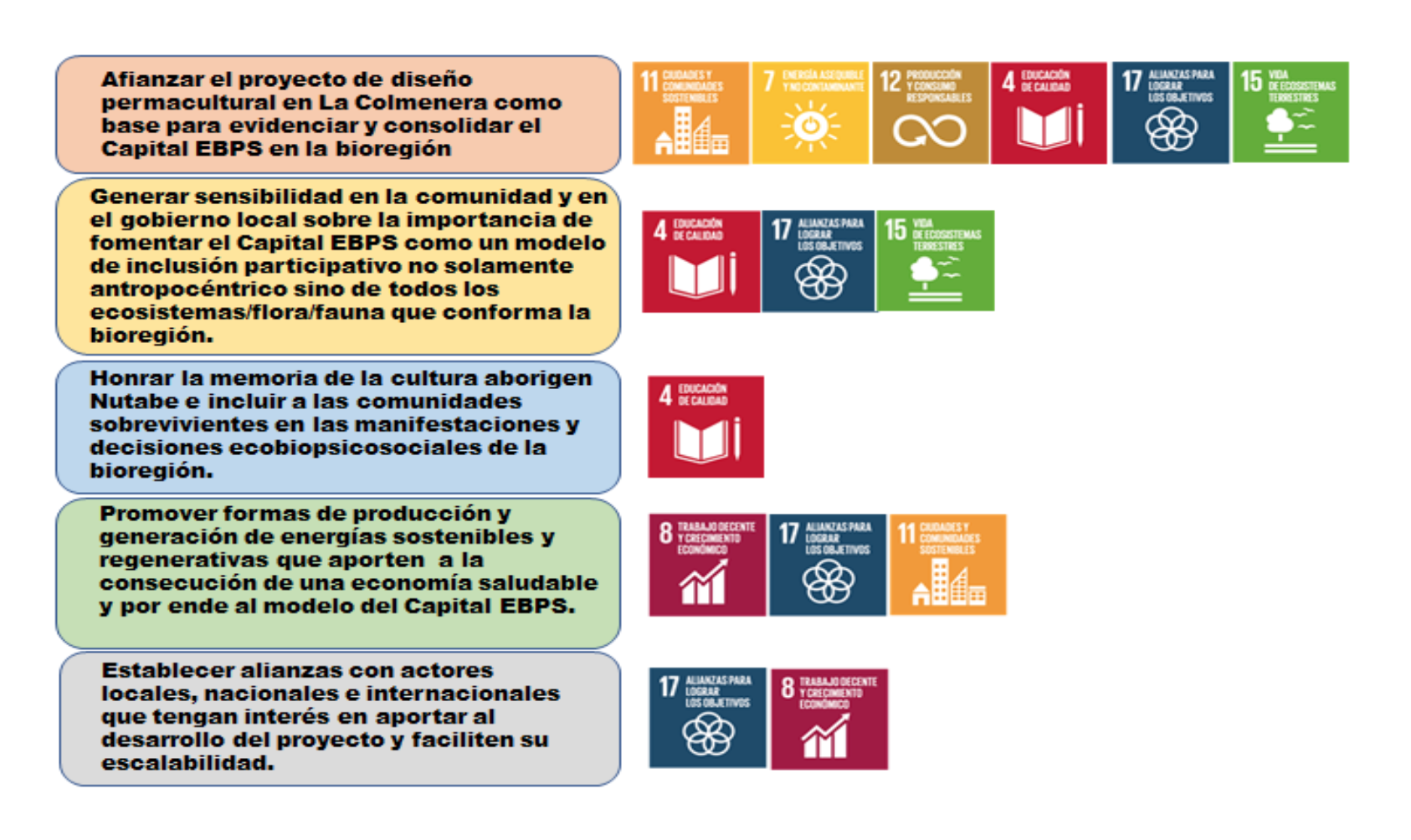 Project’s goals related to the SDGs
Project’s goals related to the SDGs
Thereby, this proposal was the seed and scope of the design process. A guideline which helped the group’s collective intelligence to define the outlook (Purpose, Vision, Values and Goals) that led us to decidedly think of La Colmenera as a Center for Ecobiopsychosocial (EBPS) Regeneration.
The Earth Charter: Values and Ethic Principles as Regenerative Design Guidelines
The values evoked by La Colmenera – EBPS Regeneration Center are essentially rooted in the Earth Charter [10*]. Declaration that greatly conveys the EBPS Capital as the core of this matter. These ethical principles related to the attitudes we adopt for our project are stated as follows:
RESPECT AND CARE FOR THE COMMUNITY OF LIFE
- We recognize that the overall species diversity inhabiting the Oikos are interdependent. We interpret such tie as the true wealth we all share in the community of life.
- We encourage a regenerative economy by which we make good use of natural resources honoring the circularity of life.
- We foster social and economic justice to achieve well-being, both for humans and human organizations, through ecology as the heart of our priorities.
- We aim for a cultural transformation which assure in future generations values, traditions and organizations that pursue genuine long-term prosperity in reciprocity with the web of life.
ECOLOGICAL INTEGRITY
- We encourage, at all levels, the adoption of regenerative ecological development plans and regulations that allow including environmental conservation/rehabilitation as the thrust of any human and organizational development intention.
- We protect the Oikos from any harm, bad practice or environmental abuse through ecoliteracy and evolutionary activism. We shall demand to those who deliberately affect it to assume the costs of their actions.
- We adopt production and consumption patterns that sustain and thrive Gaia’s regenerative capacities. Likewise, we promote the internalization of the total ecological and social costs of goods and services in their sales prices.
- We foster collaborative ecological research at local, national and international levels (glocal). Furthermore, we include, recognize and preserve traditional knowledge and spiritual wisdom from all cultures that further eco-biopsychosocial well-being.
SOCIAL AND ECONOMIC JUSTICE
- We contribute to the eradication of poverty as an ecobiopsychosocial imperative, seeking to guarantee the inherent rights all the web of life members own in an inclusive way.
- We encourage the EBPS Capital development in business so that they can reassess the governing concept of wealth absorbed by dint of the cartesian view of life.
- We drive human organizations from the EGO mindset towards the ECO paradigm in order to not only affirm human equity (gender, etc.) but also the respect of the rights of all beings in the Oikos.
- We defend the right of exploited, displaced, discriminated and violated indigenous peoples to be engage to actions and choices made in the ecobiopsychosocial systems from which they belong.
DEMOCRACY, NONVIOLENCE, AND PEACE
- We exalt ecological democracy for nurturing inclusive governance and participation as priorities of ecobiopsychosocial justice.
- We uphold the evolution of reductionist education to a comprehensive systemic education that helps to enhance a regenerative human presence on Earth.
- We safeguard all the beings that integrate the community of life from hurt, cruelty or suffering.
- We work both for a society and an interdependent community that encourages tolerance, solidarity and cooperation.
The GEDS’ 4 Dimensions as The EBPS Capital: Creative Solution
The Colmenera – EBPS Regeneration Center planning is the outcome from our experience as the GEDS program students. An inclusive non-traditional educational option for people of all genders, latitudes, ages, knowledge, cultural backgrounds and abilities, whose purpose is promoting thriving communities within planetary boundaries (Gaia Education, 2020) [11*].
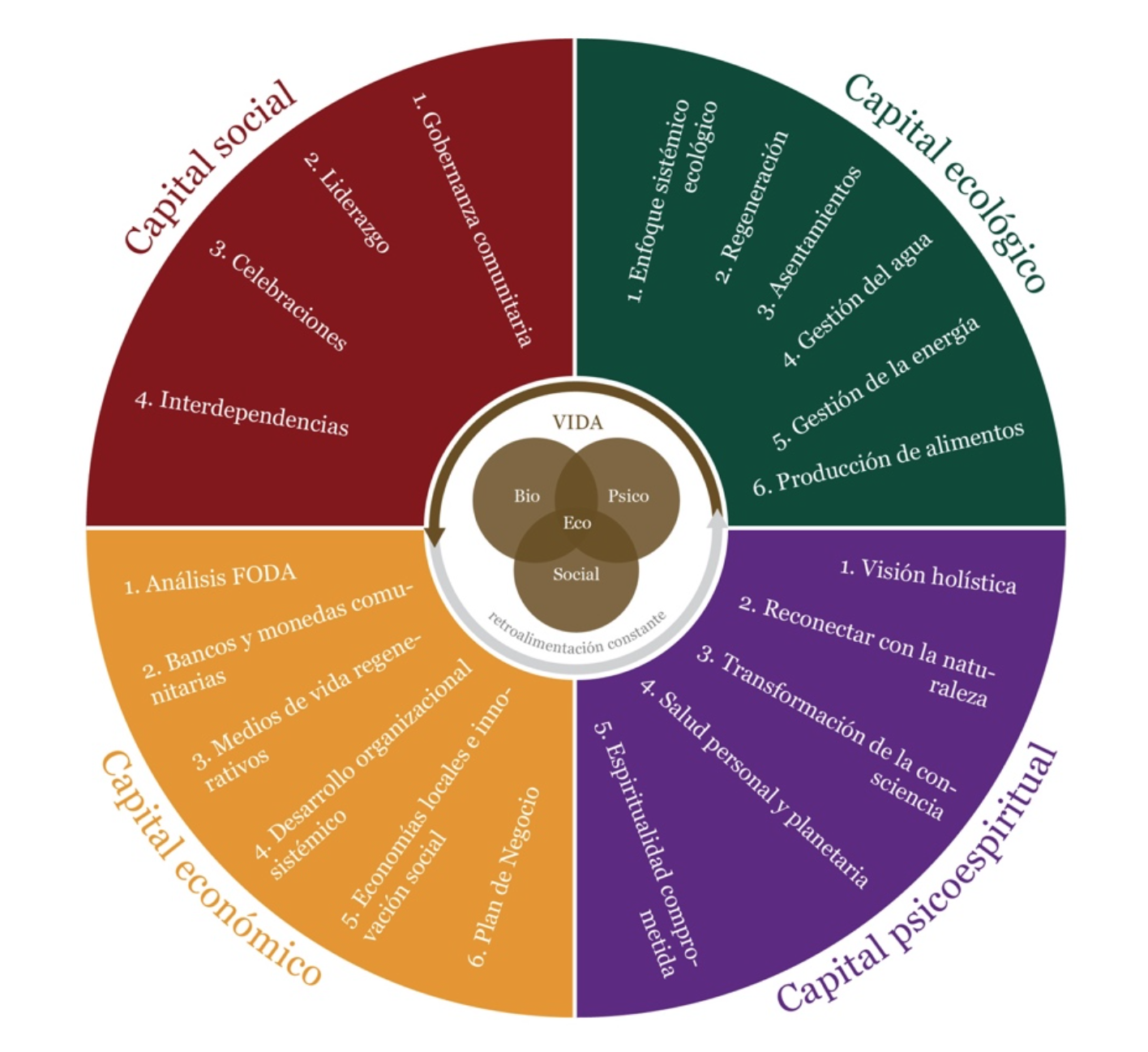 The GEDS’ 4 dimensions integrated to the EBPS Capital
The GEDS’ 4 dimensions integrated to the EBPS Capital
As crew we were convinced such ‘thriving communities’ motto promoted by Gaia Education shared the EBPS Capital idea. I had also said what I grasped within the 4 dimensions (Social, Ecological, Economic and Worldview) sparked up this systemic conversation. Hence, by seeing with heart –as the Fox would say to the Little Prince– we assumed the dimensions themselves as the methodological process we needed in order to stand the EBPS Capital as the cornerstone of this undertaking. Therefore, we approached the final report referring to ‘Capitals’ instead of ‘Dimensions’. Capitals intertwined to the holistic EBPS Capital:
- Social Capital: At La Colmenera we follow inclusive practices where both social justice, community wellness and ecological ethics assemble our educational regenerative approach. The EBPS Capital starts from our hearth.
- Ecological Capital: We start by being aware of ecosystems, productive landscapes and relationships between them. We hold soil health as the basis of regeneration and food production. We work and design from a systemic view bearing in mind both permacultural and agroecological principles.
- Economic Capital: We aim to develop a regenerative solidarity economy that soars wealth and prosperity beyond money. Likewise, a fair economy that mindfully manage the exchange of goods and services across different ways of capital.
- Psychospiritual Capital: We invoke an inclusive spiritual state that fondly invites to realize our connection with Mother Nature, with the community of life, and with ourselves.
Present Day: From Design Thinking to Action
Nowadays some of the activities addressed by La Colmenera through the Design Studio have already been launched. In addition to the permaculture zones expansion we had even started before and during the exercise, there are tasks we are attending with commitment, knowledge, share responsibility, patience, love, and besides our actual capacities to take regenerative design into action.
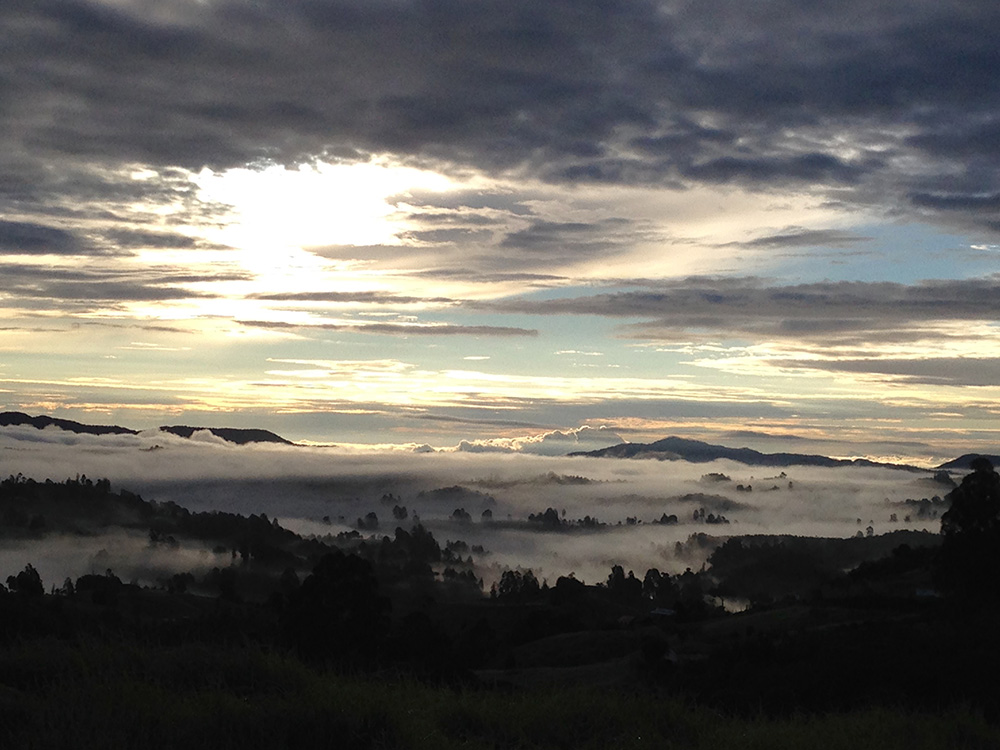 Sunrise view at La Colmenera
Sunrise view at La Colmenera
Thriving bioregional native forests and therefore preserving water sources are decided commitments. Thus we protect native flora and fauna not yet extinct. Furthermore, we are not only adapting fog collector systems (abundant natural resource in moorlands) down La Colmenera, but also crystallizing an alliance (Nebulón) in an effort to become spreaders of this solution –which from engineering mimics Nature– all over the North of Antioquia. Systems like these will allow us to conserve bioregional basins and wetlands so affected by cattle farming and agroindustry extractive practices. Additionally, from the second 2020 semester we have planned to adapt clean/renewable energy systems. Wind, sunlight, and manure from livestock are other plentiful natural resources that should be used.
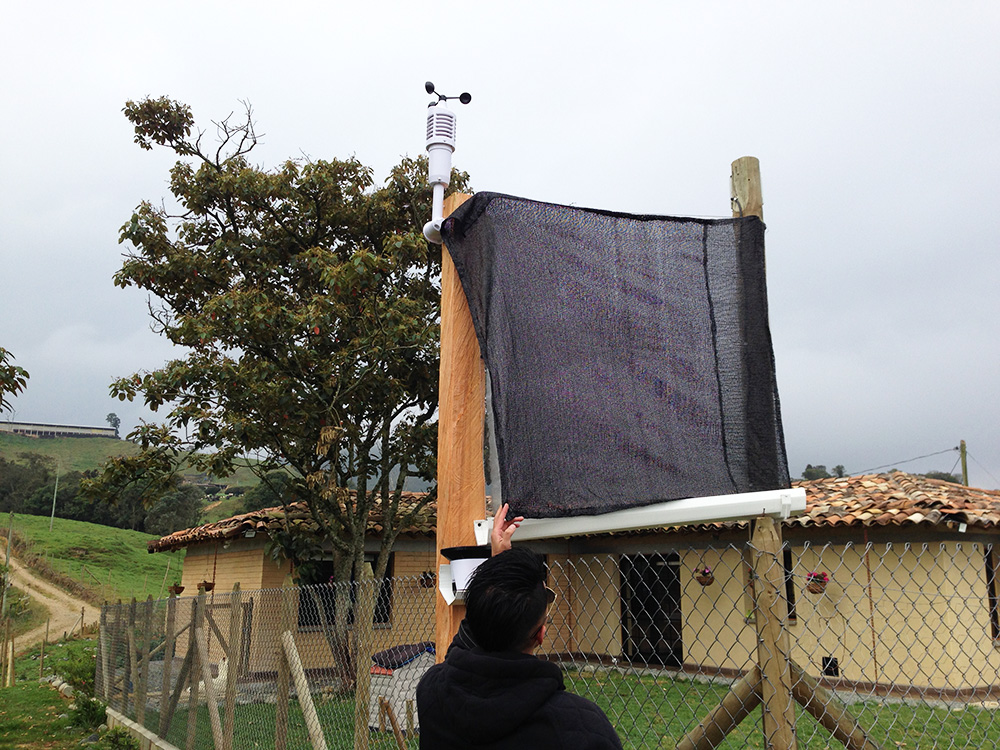 Adapting a ‘Nebulómetro’ (analysis for harvesting water from fog at La Colmenera)
Adapting a ‘Nebulómetro’ (analysis for harvesting water from fog at La Colmenera)
La Colmenera is also adapting organic farming rooted in the principles and philosophy encompassed by the agroecological science. Both for own consumption, as chance of community exchange, as well as a circular economic aid for this project. Learning the ‘lecturaleza’ is essential for agroecology since it underpins the traditional indigenous ancestral knowledge about cultivating and caring for land, working and designing with Mother and Teacher Nature.
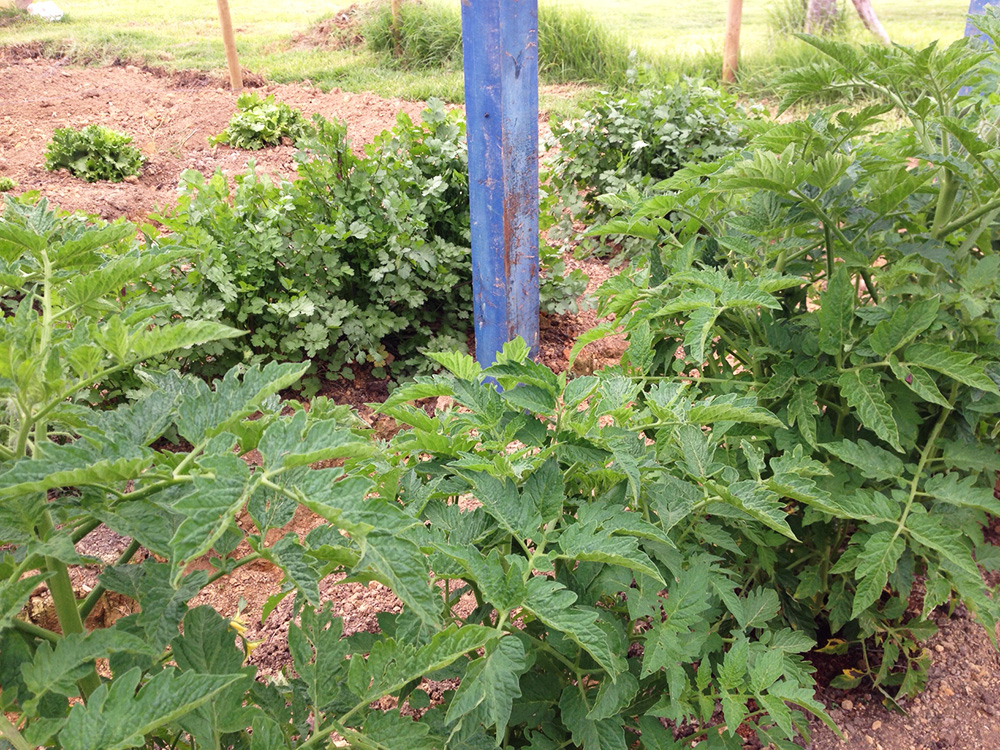 Agroecological farming at La Colmenera (tomato – coriander mutualism)
Agroecological farming at La Colmenera (tomato – coriander mutualism)
In line with the former activity, because of the Capra Course Alumni Network –a significant experience for delving into The Systems View of Life– I connected with the Chilean professor Miguel Altieri, one of the main advocates of agroecology at ‘glocal’ level. Altieri and his partner Clara Nicholls, Colombian agroecologist, have been developing an agroecological lighthouse here in the southwest of Antioquia (Colombia). I expressed to him our interest in becoming La Colmenera in an agroecological hub for the Antioquia’s north region for the near future.
 Discussion session ‘Agroecology: The Food Challenges of a Planet in Crisis’
Discussion session ‘Agroecology: The Food Challenges of a Planet in Crisis’
(Altieri et al., Medellín, Febrero 24, 2020)
In terms of our involvement with local governmental issues, La Colmenera is taking part of San Pedro’s environmental committee. There we seek to add to the regional development plan and so forth. Likewise, is an space where we can scope out ecobiopsychosocial conditions for planning the EBPS Capital in this territory.
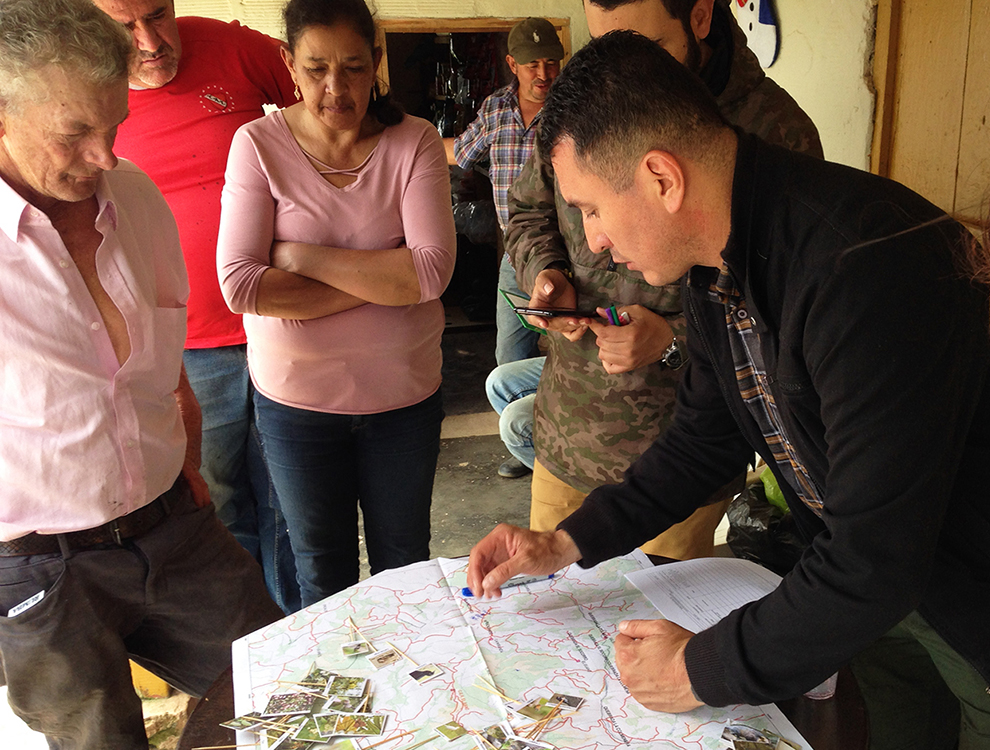 Induction on San Pedro’s Protected Areas System
Induction on San Pedro’s Protected Areas System
(Corantioquia – Environmental Committee, Vereda El Rano, La Colmenera, December 2019)
We also are initiating to lead an Ecosocial Tourism Program whereby we expect to push plans of nature tourism, inclusive community tourism, sociocultural tourism and ecoliteracy. We are furthering it in association with local initiatives and leaders. Through the agency of this program we basically intent to achieve general benefits for local ecosocial entrepreneurs, such as strengthening networks, national and international grants and collaborative work. Moreover, fostering new sustainable productive alternatives that bear in mind the entire community of life. In addition to local government, we are interweaving departmental, national and international entities as allies of a proposal based on solidarity economy.
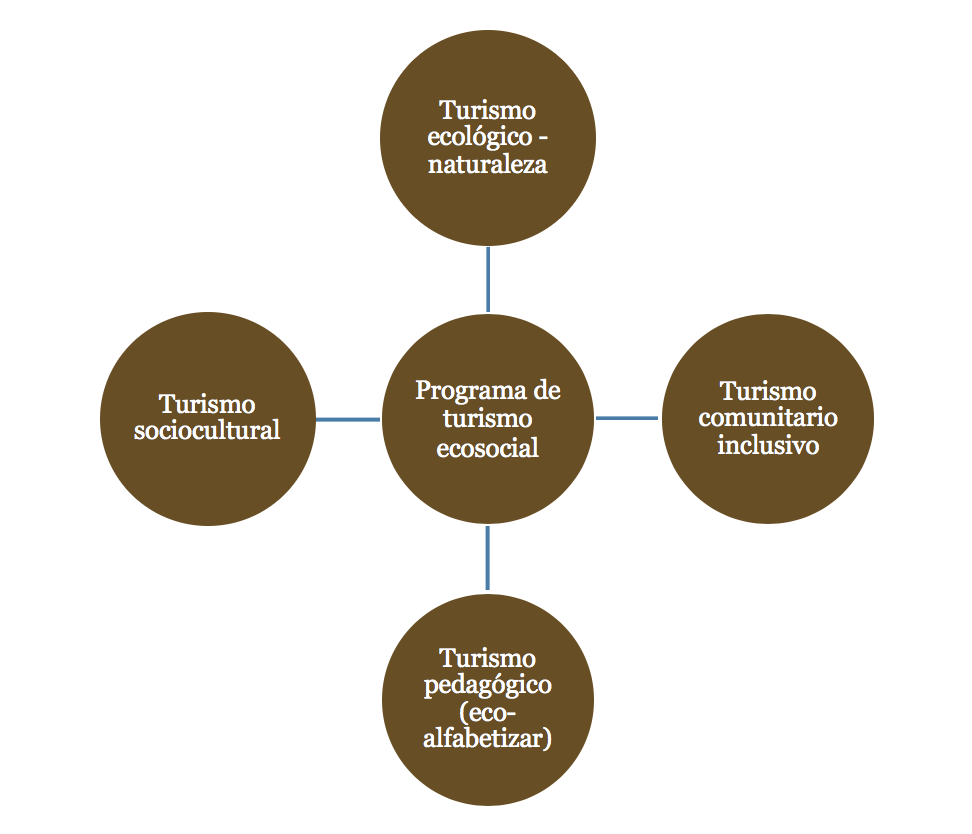 Scheme of La Colmenera’s Ecosocial Tourism Program
Scheme of La Colmenera’s Ecosocial Tourism Program
Design Team Organization
Our interaction as design team emerged by means of a conversational process convened by participatory leadership as the main pattern of organization. We acknowledged the design process would lift up higher to the extent that we boost self-determination for its proper development both individual and collectively. So that, we all assume a role to bring into being the collective intelligence that enabled us to achieve, according to the GEDS facilitators, an outstanding exercise.
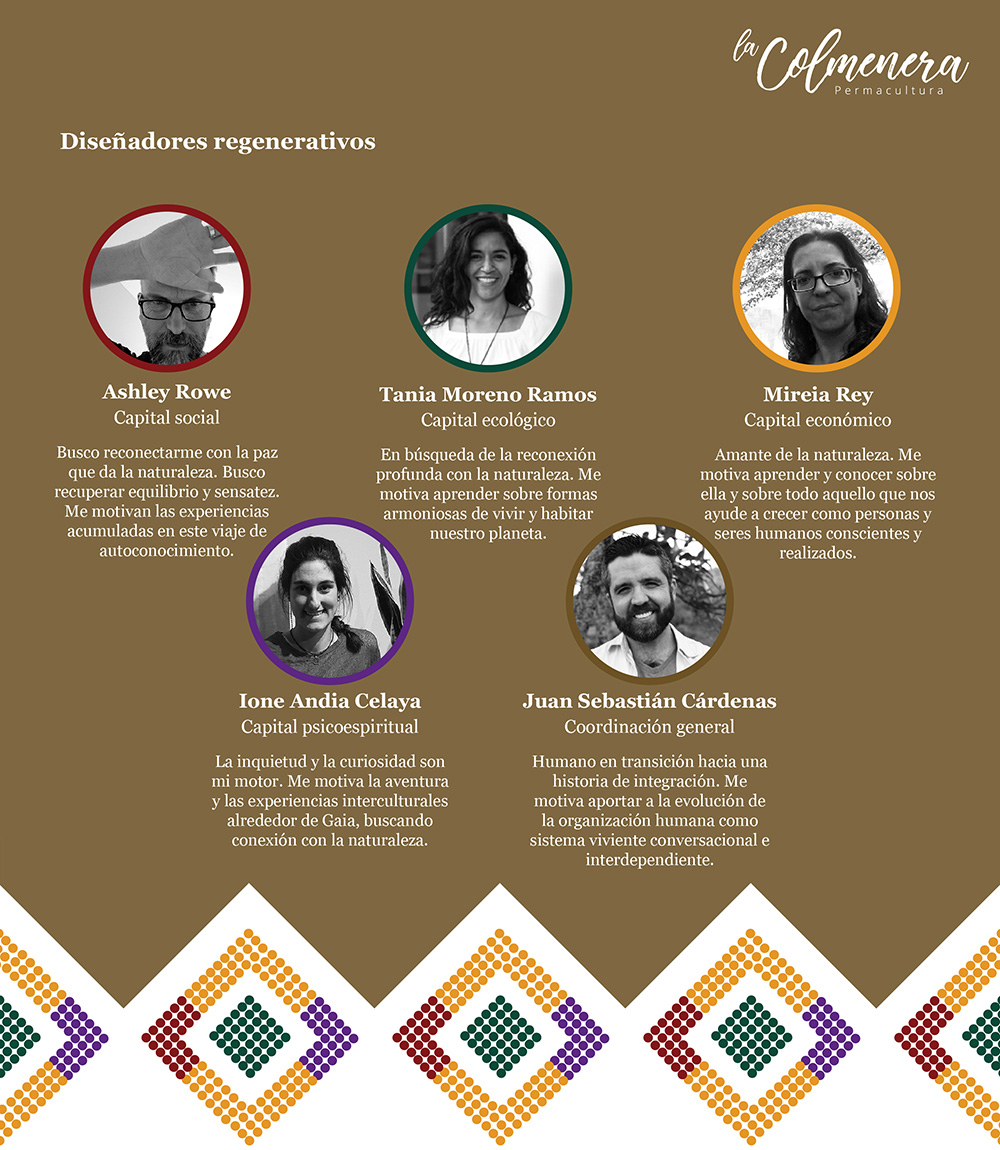
Acknowledgments
A recognition for my colleagues Tania Moreno Ramos, Ashley Rowe, Mireia Rey and Ione Andia Celaya for their worthy contributions. La Colmenera – EBPS Regeneration Center has started to emerge thanks to you. I am also grateful to both Giovanni Ciarlo and Silvia Di Blasio for their guidance, openness, and patience along this learning process. Your observations were crucial for achieving a remarkable report.
Lastly, I want to thank Mother Earth for helping me to see with heart this designing process, as well as granting me the opportunity of learning the ‘Lecturaleza’ in my Home, La Colmenera. This journey is especially dedicated to Her, to Planetary Health and Life.
[1*] Declared by The World Health Organization (WHO) as “enemy against humanity”.
[2*] Encouraging ‘solidarity’ has become the mainstream of this pandemic crisis. It’s quite evident how some business as usual have taken advantage of. It’s paramount working to prevent that ‘solidarity’ enlarge the list of ‘memes’ from traditional economy –as it has done with ‘innovation’, ‘sustainability’, ‘resilience’, among others– and genuinely emerge as value / certain attitude of human organization.
[3*] For systemic problems, systemic solutions: It’s frequent to hear many leaders ask their people to “increase collective intelligence” over these days of health crisis.
[4*] Social, Ecological, Economic and Worldview.
[5*] To bring this novel paradigm into being it’s needed to meet a collective intelligence both from social and exact sciences. Nor Economy, Health Sciences, neither Mathematics can be separated from Ecology.
[6*] Book ‘Designing Regenerative Cultures’ by Daniel C. Wahl, 2016.
[7*] Mutualism I’ve called ‘The Trilogy of Integrity’.
[8*] The Need for a New Medical Model: A Challenge for Biomedicine (Engel, 1977)
[9*] https://en.wikipedia.org/wiki/Holism_in_science
[10*] https://earthcharter.org/invent/images/uploads/echarter_english.pdf
[11*] https://www.gaiaeducation.org/
Author: Juan Sebastián Cárdenas Salas (March 18, 2020)
For reading Spanish version click here

